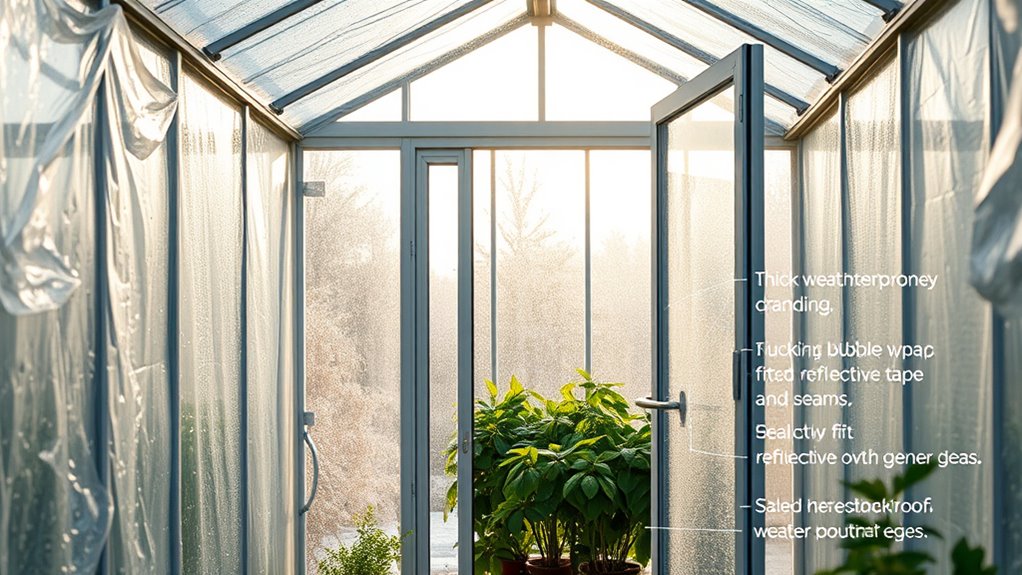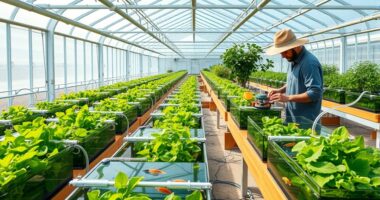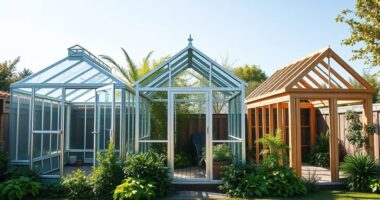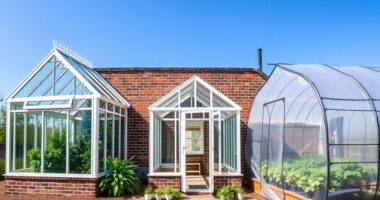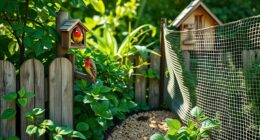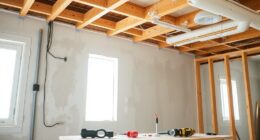To weatherproof your greenhouse for year-round use, focus on effective insulation strategies. Use materials like bubble wrap, foam boards, or insulating panels to reduce heat loss. Seal gaps with weatherstripping and caulk to improve airtightness. Add thermal curtains at night and insulate your floors with mats or mulch to maintain consistent temperatures. Combining these measures will help create a stable environment for your plants, and you’ll discover more tips as you continue exploring options for insulation.
Key Takeaways
- Use thermal curtains to trap heat and prevent cold drafts, especially during winter nights.
- Insulate the greenhouse with bubble wrap, foam boards, or insulating panels to improve thermal retention.
- Seal gaps, cracks, vents, and doors with weatherstripping and caulk to maximize airtightness.
- Add ground insulation like foam tiles or mulch to maintain consistent root temperatures.
- Combine multiple insulation layers and ensure proper sealing for effective all-year weatherproofing.
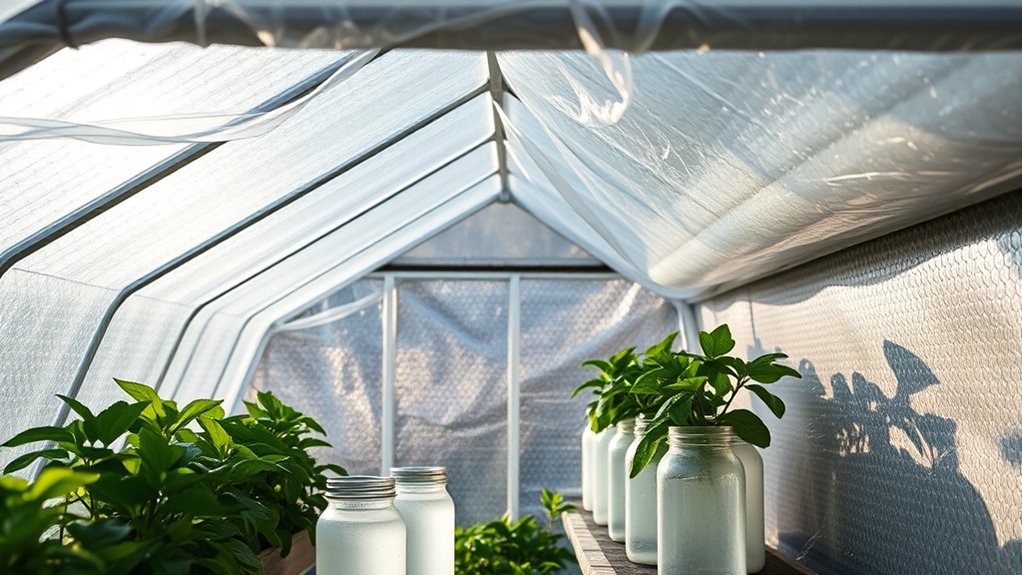
Insulating your greenhouse is essential for maintaining a stable temperature and extending your growing season. When you focus on proper insulation, you create a more controlled environment, allowing your plants to thrive even during cold months. One of the most effective ways to achieve this is by using thermal curtains. These curtains act as an extra barrier, trapping heat inside during the night and preventing cold drafts from chilling your plants. When you hang thermal curtains along the sides or at the ends of your greenhouse, you’ll notice a significant reduction in heat loss. They’re easy to install and can be drawn closed after sunset, then opened during the day to let in sunlight and warmth.
Using thermal curtains can significantly reduce heat loss and extend your growing season.
In addition to thermal curtains, you should carefully select and implement insulation materials suited for your greenhouse. Common options include bubble wrap, foam boards, and insulating panels. Bubble wrap is lightweight, affordable, and simple to install—just drape or tape it onto the interior walls and roof. It creates a layer of trapped air that acts as a buffer against cold air outside. Foam boards are denser and provide superior insulation; you can cut them to size and attach them securely to your walls and ceiling. Insulation panels, often made of rigid foam or mineral wool, offer even better thermal resistance and are ideal if you’re aiming for a more permanent solution.
When you choose insulation materials, think about their R-value, which indicates their resistance to heat transfer. Higher R-values mean better insulation. For instance, you might combine multiple layers of bubble wrap or foam panels for extra insulation during particularly cold months. You should also focus on sealing any gaps or cracks in your greenhouse structure, as even small openings can lead to significant heat loss. Use weatherstripping around vents and doors, and consider sealing joints with caulk or adhesive to guarantee your insulation works efficiently.
To maximize your greenhouse’s insulation, don’t forget about the floor. Adding insulating mats or foam tiles underneath your plants can help retain heat from the ground and prevent cold drafts from entering through the base. Covering the soil with mulch or a thermal blanket during winter nights can also insulate the roots and maintain a more consistent temperature. Additionally, understanding the importance of insulating materials can help you choose the most effective options for your specific climate.
Frequently Asked Questions
What Are the Best Insulation Materials for Different Greenhouse Types?
When choosing insulation materials, you should consider your greenhouse type and climate. For glass or polycarbonate greenhouses, bubble wrap offers easy insulation installation and is lightweight. For more robust options, foam boards provide excellent thermal resistance, while reflective materials like mylar help maximize heat retention. A thorough material comparison helps you select the best insulation, ensuring your greenhouse stays warm year-round.
How Do I Prevent Condensation Buildup Inside My Insulated Greenhouse?
Imagine your greenhouse as a delicate glasshouse, where moisture can turn into sneaky fog. To prevent condensation buildup, you should focus on humidity control and install vapor barriers to keep moisture from clinging to surfaces. Ventilate regularly to release excess humidity and regulate temperature. These steps create a balanced environment, like a gentle breeze clearing fog, ensuring your plants thrive without the risk of mold or water damage.
What Is the Average Cost of Insulating a Greenhouse?
When estimating the cost of insulating your greenhouse, you’ll want to take into account material options like bubble wrap, polycarbonate panels, or foam boards. Cost estimates vary depending on size and insulation quality, typically ranging from $200 to over $1,000. You’ll also need to factor in installation costs if you’re hiring help. Overall, planning your budget around these factors ensures you choose the best insulation for your greenhouse needs.
How Does Insulation Affect Greenhouse Ventilation and Airflow?
Think of insulation as the backbone of your greenhouse’s health. It impacts ventilation and airflow regulation by trapping warm air, which can reduce natural airflow and humidity control. You might notice less breeze and slower temperature changes, making it essential to balance insulation with proper ventilation. To prevent stuffiness, consider installing vents or fans, ensuring your plants get fresh air and ideal humidity levels year-round.
Can I Retrofit Insulation Into an Existing Greenhouse Easily?
You can retrofit insulation into your existing greenhouse, but expect some DIY installation challenges. Start by evaluating your structure and choosing suitable insulation materials. You’ll need to carefully add insulation without obstructing ventilation or sunlight, which can be tricky. It’s a manageable project if you plan properly, but be prepared for some trial and error. Proper sealing and securing are key to ensuring effective insulation without compromising airflow.
Conclusion
Think of your greenhouse as a cozy castle, where warmth and protection keep your plants thriving all year. By insulating it, you’re building sturdy walls against the harshest storms, creating a sanctuary that nurtures growth no matter the weather outside. With a little effort, you’re transforming your space into a resilient fortress—a haven where your plants can flourish in harmony, rain or shine. Your green kingdom is now weatherproof and ready for any season ahead.
